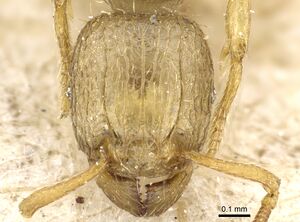Tetramorium termitobium
| Tetramorium termitobium | |
|---|---|

| |
| Scientific classification | |
| Kingdom: | Animalia |
| Phylum: | Arthropoda |
| Class: | Insecta |
| Order: | Hymenoptera |
| Family: | Formicidae |
| Subfamily: | Myrmicinae |
| Tribe: | Crematogastrini |
| Genus: | Tetramorium |
| Species: | T. termitobium |
| Binomial name | |
| Tetramorium termitobium Emery, 1908 | |
A rainforest species that has been found foraging on the ground and in leaf litter, rotten logs, and under a stone.
Identification
Bolton (1980) - Characters serving to separate T. termitobium from its closest relatives include its short pilosity, broad head, irregular promesonotal sculpture and less strongly developed frontal carinae. See under Tetramorium intonsum, Tetramorium jugatum and Tetramorium shilohense.
This and the other three species listed above belong to a complex of four small yellow species in this species group. Together they are characterized by their moderately developed frontal carinae, coarse sculpture, small (as opposed to minute) eyes with 3-5 ommatidia in the greatest diameter, and vestigial or very feeble antennal scrobes.
Keys including this Species
Distribution
Distribution based on Regional Taxon Lists
Afrotropical Region: Democratic Republic of Congo (type locality), Gabon, Ivory Coast, Uganda.
Distribution based on AntMaps
Distribution based on AntWeb specimens
Check data from AntWeb
Countries Occupied
| Number of countries occupied by this species based on AntWiki Regional Taxon Lists. In general, fewer countries occupied indicates a narrower range, while more countries indicates a more widespread species. |

|
Estimated Abundance
| Relative abundance based on number of AntMaps records per species (this species within the purple bar). Fewer records (to the left) indicates a less abundant/encountered species while more records (to the right) indicates more abundant/encountered species. |

|
Biology
Castes
Worker
Images from AntWeb
   
| |
| Syntype of Tetramorium termitobium. Worker. Specimen code casent0904845. Photographer Z. Lieberman, uploaded by California Academy of Sciences. | Owned by MSNG, Genoa, Italy. |
Nomenclature
The following information is derived from Barry Bolton's Online Catalogue of the Ants of the World.
- termitobium. Tetramorium termitobium Emery, 1908b: 186 (w.) DEMOCRATIC REPUBLIC OF CONGO. See also: Bolton, 1980: 292.
Unless otherwise noted the text for the remainder of this section is reported from the publication that includes the original description.
Description
Worker
Bolton (1980) - TL H - 2·8. HL 0·65-0·66, HW 0·60-0·62. CI 92- 94. SL 0'5(}-0'52, SI 81- 83. PW 0·38-0·40. AL 0·70-0·72 (2 measured ),
Mandibles longitudinally striate. Anterior clypeal margin entire, without notch or impression. Frontal carinae reaching back beyond the level of the eyes but only weakly developed, with a feeble rim; fading out on the occiput and merging with the the occipilal sculpture. Antennal scrobes very weak. indicated only by a shallow broad concavity of the sides below the frontal carinae. Eyes small. smaller than the maximum width of the scape and with only 3-4 ommatidia across the greatest diameter. Maximum diameter of eye 0'07-0'08, about 0.11 - 0.13 x HW, with the head in full-face view the sides shallowly but evenly convex, the maximum width being about at the level of the eyes so that Cl > 90. With the alitrunk in profile the metanotal groove distinctly impressed. The dorsum of the propodeum raised into a low triangular prominence immediately behind the groove and then falling away to the spines. Propodeal spines stoutly triangular, acute apically and broad across the base. Metapleural lobes triangular and acute. Node of petiole in profile with the anterodorsal angle a right-angle which is quite sharply defined. Posterodorsal angle not nearly so sharply defined. the dorsum meeting the posterior face in a narrow curve. In dorsal view the petiole node very slightly broader than long. Dorsum of head finely irregularly longitudinally rugulose. the rugulae faint in places. Occipital region of head with a fine ruguloreticulum. Dorsal alitrunk irregularly rugose with numerous cross-meshes which form a loose. open, partial reticulum, particularly on the promesonotum. Dorsal surface of petiole with faint traces of sculpture but the postpetiole virtually smooth with only the faintest vestiges of sculpture present and most of its surface smooth. First gastral tergite unsculptured. All dorsal surfaces of head and body with scattered short erect hairs, distinctly shorter and more sparse than in relaxed species. Tibiae of middle and hind legs only with short decumbent to appressed pubescence. Colour yellow.
Type Material
Bolton (1980) - I have not been able to see the holotype of termitobium and in consequence this interpretation of the species rests upon the original description and upon a type compared specimen (by W. L. Brown) in the Museum of Comparative Zoology.
References
- Bolton, B. 1980. The ant tribe Tetramoriini (Hymenoptera: Formicidae). The genus Tetramorium Mayr in the Ethiopian zoogeographical region. Bulletin of the British Museum (Natural History) Entomology. 40(3):193-384.
- Emery, C. 1908c. Descriptions d'une genre nouveau et de plusieurs formes nouvelles de fourmis du Congo. Ann. Soc. Entomol. Belg. 52: 184-189 (page 186, worker described)
References based on Global Ant Biodiversity Informatics
- Bolton B. 1980. The ant tribe Tetramoriini (Hymenoptera: Formicidae). The genus Tetramorium Mayr in the Ethiopian zoogeographical region. Bulletin of the British Museum (Natural History). Entomology 40: 193-384.
- Lévieux J. 1972. Les fourmis de la savane de Lamto (Côte d'Ivoire): éléments de taxonomie. Bulletin de l'Institut Fondamental d'Afrique Noire. Série A. Sciences Naturelles 34: 611-654.

